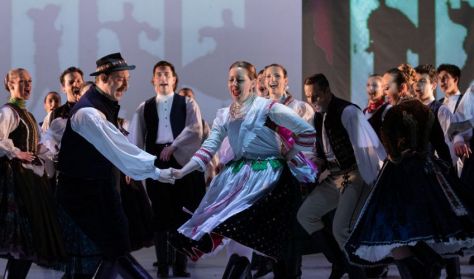
Körtánc • Magyar Állami Népi Együttes
A Magyar Állami Népi Együttes előadása a száz évvel ezelőtti trianoni békediktátum emlékezete jegyében készült. Læs mere

A Magyar Állami Népi Együttes előadása a száz évvel ezelőtti trianoni békediktátum emlékezete jegyében készült. Læs mere
Ön egy múltbeli eseményre keresett rá. Kérjük, válogasson aktuális kínálatunkból a Jegy.hu keresőjében!
Last event date: Torsdag, 11. Juli 2024 20:30
Az antológiaszerű válogatás a Kárpát-medence magyarsága és a vele sorsközösségben élő nemzetiségek (románok, szlovákok, szerbek és horvátok, svábok, ruszinok, zsidók, cigányok) folklórjából inspirálódva járja körbe, táncolja körbe a Felvidéket, Kárpátalját, Erdélyt, a Délvidéket, és a „Kis Magyarországot”. Hitet téve az összetartozás megkérdőjelezhetetlen valóságáról, nagy ívű panorámaként mutatja fel azt a paraszti örökséget, azokat a páratlan kulturális és szellemi javakat, melyeket az ezeréves együttélés hagyott ránk.
Az antológiaszerű előadás tematikája a Bartók által megfogalmazott igazságot erősíti, miszerint az itt élő népek művészetének évszázadokon átívelő kölcsönhatása egyetemes, elválaszthatatlan kultúrát hozott létre. Mi, jelen világunkban élő emberek is látjuk a száz évnyi „távolságot”, de hisszük, hogy bár távolinak tűnik, mégis közeli!
Előadja: a Magyar Állami Népi Együttes tánckara és zenekara, valamint vendégművészek
Szólót énekel: Kubinyi Júlia, Hetényi Milán
Vendégként közreműködik: KOLO együttes
Zenei szerkesztő: Agócs Gergely, Gera Attila, Kelemen László, Pál István Szalonna
Zeneszerző: Kelemen László
Koreográfus: Fitos Dezső, Furik Rita, Kocsis Enikő, Kökény Richárd, Mihályi Gábor, Richtarcsik Mihály
Zenekarvezető: Radics Ferenc
Tánckarvezető: Ágfalvi György
Tánckari asszisztensek: Borbély Beatrix, Jávor Katalin, Farkas Máté, ifj. Zsuráfszky Zoltán
Rendező-koreográfus: Mihályi Gábor
Művészeti vezető: Pál István Szalonna
Együttesvezető: Mihályi Gábor
Miként az ember leveti elnyűtt ruháit és újakat ölt magára, úgy adja fel a lélek is az öreg és hasznavehetetlen testeket, hogy újakat fogadjon el helyükbe." - idézet a Bhagavad-gítából
„Egy mindenkiért! Mindenki egyért!” – Nincs ismertebb jelmondat a testőrök köszöntésénél!
A Ringató foglalkozásokon megismertetjük a kisgyermekes családokkal a zenei nevelés lehetőségeit. Célunk, hogy a szülők és a gyerekek átéljék a közös éneklés és játék élményét. Várunk mindenkit, aki maga is úgy érzi, fontos az, hogy a művészet eszközeivel neveljünk, aki szívesen énekel, bővíti a dalkincsét, vagy éppen önmaga bátortalan az éneklésben.
Az adventi időszak újdonsága lesz Paár Julcsi és a Fitos Dezső Társulat ünnepre hangoló, élőzenével, hagyományos és kortárs táncelemekkel, autentikus…
Mire vágyik valójában az ember? Nehéz a válasz, hiszen egy tökéletesre teremtett világból a kiutat, a kiűzetés után az Édenbe…
A Grimm testvérek kedves és tanulságos meséje emberi erényekről és az igazságról, amelyben mindnyájan bízunk. Sok tánccal és vidámsággal, ami…
enhed(er) i kurven
total:
Tiden er udløbet. Start venligst forfra med at vælge billetter.
